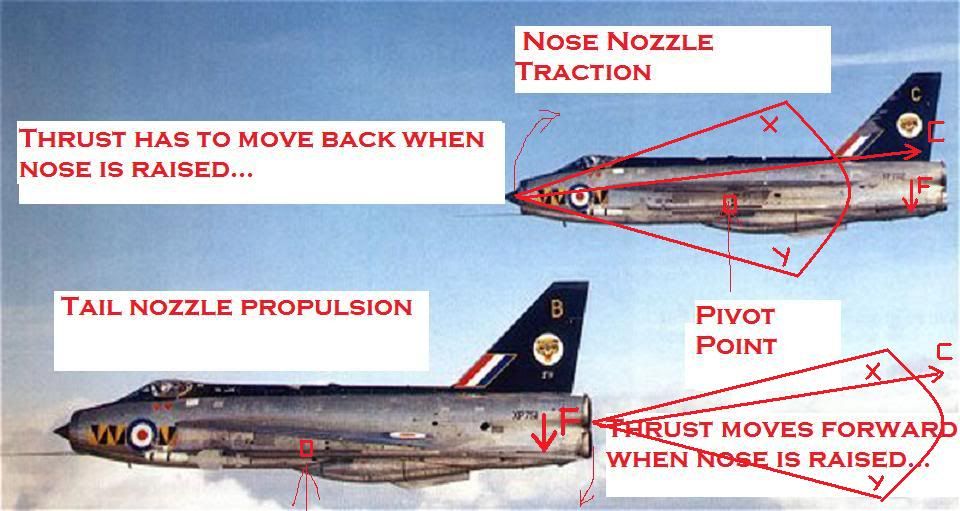Quote:
Originally Posted by JtD

No, it doesn't.
First, the force vector of the prop points inwards, due to the angle of attack the aircraft uses in a turn, it pulls the aircraft to the inside and therefore more power lowers the wingloading and improves turning.
Second, more power increases the airflow over the wing, thus increasing the wings lifting ability and therefore improves turning.
Third, any effect the prop forces might have on turning, will be canceled out by the elevator, which itself only has a minimal impact on drag.
And finally, in a sustained turn, you need speed to do the turning, more speed means more g's, means more turnrate. If you reduce thrust, you lose speed and won't be able to sustain a better turn.
---
The same thing got posted on the ubi-board, and the topic was locked immediately. Take it as a measure for the quality of the original post. It's complete and utter nonsense.
|
-First of all JTD, it was locked because the same general subject had been discussed in several massive multiple parts threads for over a year there, and the obviously hostile moderators decided it should be kept in those same massive threads... See the reason given by the moderator at the bottom of the locked thread here:
http://forums.ubi.com/eve/forums/a/t...3/m/8811012078
Do you really want to make statements that are so stupidly easy to disprove?
An indication of the quality of moderating there is that I had to personally contact the moderators to delete obvious and stupid personal attacks instead of them doing their jobs... AND... One OTHER moderator, who explained quite correctly why a "vertical turn" in 1943 parlance is short for a "vertical bank turn", in the context of this SpitV vs FW-190A article:
http://img30.imageshack.us/img30/471...sononfw190.jpg
Meaning therefore a HORIZONTAL turn... This "moderator" later DELETED his OWN explanation that was favorable to my point of view, and REFUSED to re-iterate it, because of course it was far too favourable to my argument, and left no wiggle room whatsoever for the pathetic interpretation of the text that there was an "ever diminishing circle" vertical loop in there-roll eyes-... (I do wish the narrating pilot had not used a term that allowed this sad manipulation, but he certainly could not have anticipated how blind and stubborn, and willing to distort, people would become to the obvious context he meant to convey...)
If someone here is familiar with the WWII lingo "vertical turn" being shorthand for "vertical bank turn", feel free to weight in: The context of the text makes the meaning obvious, in any case, to those with an open mind...
So in short, moderators there deleted things they themselves STATED, and know to be true, in order not to support my arguments, and I had to argue over and over with later posters who clung pathetically to their erroneous and biaised interpretation of this text, perhaps numbering JTD among them, if I am not mistaken?
The actual "technical point" now...:
Your argument that the prop points towards the inside of the turn is particularly sad: First of all, a straight line cannot point inside a continuous curve (circle...): Only a curve can do that: I would think that would be obvious...
Second, you obviously fail to realize that to raise the angle of attack, you have to load up the wing with all the forces that want it to go straight in the first place... And that includes the prop thrust direction, which never stops NOT wanting to go straight for your convenience THROUGHOUT the turn, as long as the elevator is deflected in fact...
Third, an aggravating factor occurs when you raise the prop: The top half of the prop disc is more loaded by this than the bottom half, because it has to go slower on the inside of the turn (the whole purpose of the elevator's raised deflection is in fact to slow down the top half of the aircraft, of which the prop disc top half is, very unfortunately for your argument, part of...), and this DEFLECTS the thrust direction slightly towards the OUTSIDE forward direction of the turn (in the real world, not the mathematical world...), thus pushing down further on the wing, thereby increasing the wing load.
The secondary difference here with a jet is that the prop thrust direction is more deflected because of the prop's large width, and narrow 90° connection to the nose, which provides more of a lever, and this deflection of the thrust line moves its axis AWAY from the point of rotation inside the wings, while on a jet's rear propulsion the same, but more modest, thrust deflection occurs (since the top half of the jet thrust is also slower), but that makes it CLOSER to the center of rotation inside the wing, as you can see in the crude graphic below, thereby reducing rotation resistance leverage, not increasing it as it does for frontal traction rotation...:

All these points are pretty basic and obvious, and please note that in over a year of argueing over this in two other gaming forums, not even the slightest begining of a sound argument against this has surfaced yet...
The notion that propulsion and traction behave the same on any object is a pure theoretical construct. Frankly, I'm pretty sure I learned in kindergarden that pulling a wheelbarrow behind you made it easier for the one wheel to follow a yellow painted line compared to pushing it...
I really wonder what the problem is in understanding this now...
Gaston